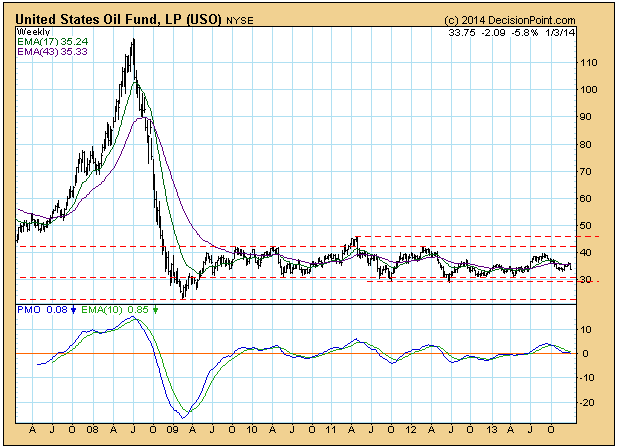The chart for USO (U.S. Oil Fund) has been confusing for some time.
Most recently USO rallied sharply from its November low, only to drop sharply from its December high, taking back nearly all of the gains. Typical action over the last year is that sharp price changes in one direction are followed by sharp reversals. Moving average analysis shows the 20-EMA below the 50-EMA (nominally intermediate-term bearish), and the 50-EMA is below the 200-EMA (nominally long-term bearish). Bearish EMA relationships aside, we can see that the last year has produced many EMA crossovers and reversals, so, while we consider the trend to be down in all time frames, the trend in a broader context is indecisive.
By zooming back to a seven-year weekly chart we get a much clearer understanding of what is probably driving current prices. This is one of the best examples of a parabolic rise and collapse that we are likely to find. First there is the frenzied buying, driving prices up in a nearly vertical path. Then upward momentum ceases abruptly and prices collapse, sometimes at an even steeper angle than they advanced. The final phase is when prices enter a basing pattern, which is a trading range wherein all the craziness that preceded it is digested in preparation for the next advance. This can take years and years.
Conclusion: Our nominal EMA analysis says that USO is in a down trend, but looking at actual price movement over a long period, we can see that USO has been in a basing pattern since 2009. This sideways movement can subject some timing models to unprofitable whipsaw, and the best approach would be to try to "work the range" -- sell at the top of the range and buy at the bottom -- rather than try to anticipate the eventual breakout from the trading range and the next large advance.
by Carl Swenlin
- English (UK)
- English (India)
- English (Canada)
- English (Australia)
- English (South Africa)
- English (Philippines)
- English (Nigeria)
- Deutsch
- Español (España)
- Español (México)
- Français
- Italiano
- Nederlands
- Português (Portugal)
- Polski
- Português (Brasil)
- Русский
- Türkçe
- العربية
- Ελληνικά
- Svenska
- Suomi
- עברית
- 日本語
- 한국어
- 简体中文
- 繁體中文
- Bahasa Indonesia
- Bahasa Melayu
- ไทย
- Tiếng Việt
- हिंदी
Crude: Chop, Chop, Chop
Published 01/05/2014, 12:58 AM
Updated 07/09/2023, 06:31 AM
Crude: Chop, Chop, Chop
Latest comments
Loading next article…
Install Our App
Risk Disclosure: Trading in financial instruments and/or cryptocurrencies involves high risks including the risk of losing some, or all, of your investment amount, and may not be suitable for all investors. Prices of cryptocurrencies are extremely volatile and may be affected by external factors such as financial, regulatory or political events. Trading on margin increases the financial risks.
Before deciding to trade in financial instrument or cryptocurrencies you should be fully informed of the risks and costs associated with trading the financial markets, carefully consider your investment objectives, level of experience, and risk appetite, and seek professional advice where needed.
Fusion Media would like to remind you that the data contained in this website is not necessarily real-time nor accurate. The data and prices on the website are not necessarily provided by any market or exchange, but may be provided by market makers, and so prices may not be accurate and may differ from the actual price at any given market, meaning prices are indicative and not appropriate for trading purposes. Fusion Media and any provider of the data contained in this website will not accept liability for any loss or damage as a result of your trading, or your reliance on the information contained within this website.
It is prohibited to use, store, reproduce, display, modify, transmit or distribute the data contained in this website without the explicit prior written permission of Fusion Media and/or the data provider. All intellectual property rights are reserved by the providers and/or the exchange providing the data contained in this website.
Fusion Media may be compensated by the advertisers that appear on the website, based on your interaction with the advertisements or advertisers.
Before deciding to trade in financial instrument or cryptocurrencies you should be fully informed of the risks and costs associated with trading the financial markets, carefully consider your investment objectives, level of experience, and risk appetite, and seek professional advice where needed.
Fusion Media would like to remind you that the data contained in this website is not necessarily real-time nor accurate. The data and prices on the website are not necessarily provided by any market or exchange, but may be provided by market makers, and so prices may not be accurate and may differ from the actual price at any given market, meaning prices are indicative and not appropriate for trading purposes. Fusion Media and any provider of the data contained in this website will not accept liability for any loss or damage as a result of your trading, or your reliance on the information contained within this website.
It is prohibited to use, store, reproduce, display, modify, transmit or distribute the data contained in this website without the explicit prior written permission of Fusion Media and/or the data provider. All intellectual property rights are reserved by the providers and/or the exchange providing the data contained in this website.
Fusion Media may be compensated by the advertisers that appear on the website, based on your interaction with the advertisements or advertisers.
© 2007-2024 - Fusion Media Limited. All Rights Reserved.

